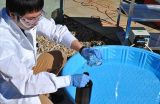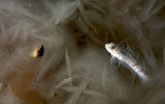Does size matter? MRI imaging sheds light on athletes most at risk for severe knee injury
2014-09-23
(Press-News.org) The successful rise and fall of an athlete's moving body relies on an orchestrated response of bones, joints, ligaments and tendons, putting the many angles and intersecting planes – literally the geometry – of a critical part like a knee joint to the test. But it's more than just a footfall error at the root of one of the most devastating of sports injuries: the ACL or anterior cruciate ligament tear. In fact, size – of the femoral notch that sits at the center of the knee joint – and volume of the ACL combine to influence the risk of suffering a noncontact ACL injury. Additional geometric characteristics of the knee, such as the slope of the articular surfaces, are involved with risk of injury.
Several recent studies – including a highly-controlled study of first-time ACL injuries in Vermont high school and college athletic team members – conducted by University of Vermont McClure Professor of Musculoskeletal Research Bruce Beynnon, Ph.D., and colleagues have examined multiple factors like the size of the femoral notch to try and explain why some people are at greater risk for injury than others. With only 200,000 to 300,000 injuries per year, ACL injuries are far less common than ankle ligament injuries, which number more than two million injuries annually. However, ACL injuries can end sports careers and are proven to lead to the early onset of osteoarthritis.
"It's a concern because its highly likely that an individual that suffers this injury will progress to end-stage arthritis in 15 years and the only solution at that point in time – knee joint replacement – only lasts about 15 to 20 years in an active individual," explains Beynnon.
While the rate of ACL injuries across the U.S. haven't changed over time, says Beynnon, he and his team have looked at and continue to research the many variables at play when this injury takes place.
In their August 2014 American Journal of Sports Medicine study, titled "Relationship between the risk of suffering a first time noncontact ACL injury and geometry of the femoral notch and ACL: A prospective cohort study with a nested case-control analysis," he and colleagues have "very accurately characterized the incidence rate and magnitude of this problem in Vermont," shares Beynnon.
The researchers examined 88 student athletes – 27 male and 61 female – who suffered first-time, noncontact ACL injuries during the study and compared their measurements – taken using MRI (magnetic resonance imaging) images of their knees – to a non-injured control group of 88 athletes (same male-female breakdown) from the same teams, with the same extrinsic factors, like environment, playing surface, training, footwear, level of competition, and coaching.
These measurements led them to look at the point where the ACL sits in the center of the knee – the femoral notch – where they measured its width, as well as ACL volume using MRI technology in the University of Vermont's MRI Center for Biomedical Imaging. One of the findings they discovered is that the risk of injury increased as the size of the femoral notch and ACL decreases.
"Prognostic studies are designed to identify who is likely to suffer injury so we can target injury prevention programs at them, and determine why they are at increased risk so we can inform the development of the programs to reduce the risk of injury and re-injuries of the same kind," says Beynnon.
In a parallel five-year epidemiological study, also published in the August 2014 American Journal of Sports Medicine, the researchers reported on "The Effects of Level of Competition, Sport, and Sex on the Incidence of First-Time Noncontact Anterior Cruciate Ligament Injury."
From the data they collected from a total of 38 institutions located throughout Vermont,, colleges reported 48 ACL injuries during the sport seasons studied, while high schools reported 53 injuries. The research team learned that college athletes had a significantly higher ACL injury risk than high school athletes – around two-fold – and that female athletes were two times more at risk for ACL injuries than males. In comparison to athletes taking part in Lacrosse, risk of ACL injury was significantly greater among those participating in soccer and rugby.In their conclusion, Beynnon and the study's authors state "An athlete's risk of having a first-time noncontact ACL injury is independently influenced by level of competition, the participant's sex, and type of sport they participate in, and there are no interactions between their effects. Female college athletes have the highest risk of having a first-time noncontact ACL injury among the groups studied."
"The first step is to establish the athletes most at risk; targeting interventions comes second."
He and colleagues are currently conducting a multivariable study that has 109 participants. They are looking at the role of a host of different factors to try to further identify those at increased risk for ACL injury.
"It's not just biomechanics, it's biomechanics and biology," Beynnon says, adding that family history – a genetic link – could be the driver of such variables as problems with ACL collagen synthesis and degradation, joint laxity, exercise and diet, body mass index, and an individual's inflammatory response.
In five to ten years, Beynnon hopes his group can repeat their epidemiological study to affirm their findings, test the high school and college athlete model on a different, independent sample of individuals, and is considering developing an intervention study
"Primary prevention is the ultimate goal," says Beynnon. "We want to reduce the risk of injury and burden of disease for this young age group."
INFORMATION:
In addition to Beynnon, University of Vermont coauthors on the two American Journal of Sports Medicine studies include: Darryl Whitney, M.D.'13; Daniel Sturnick, M.S.; Pamela Vacek, Ph.D., Mike DeSarno, M.S.; Mack Gardner-Morse, M.S.; Timothy Tourville, Ph.D., A.T.C.; Helen Smith, M.S, A.T.C; James Slauterbeck, M.D.; Robert Johnson, M.D.; and Maira Newell, B.S.
Beynnon and colleagues' research has been supported by a National Institutes of Health Grant: (RO1 AR050421) and Department of Energy Grant (SC00017).
ELSE PRESS RELEASES FROM THIS DATE:
Infant cooing, babbling linked to hearing ability, MU researcher finds
2014-09-23
COLUMBIA, Mo. – Infants' vocalizations throughout the first year follow a set of predictable steps from crying and cooing to forming syllables and first words. However, previous research had not addressed how the amount of vocalizations may differ between hearing and deaf infants. Now, University of Missouri research shows that infant vocalizations are primarily motivated by infants' ability to hear their own babbling. Additionally, infants with profound hearing loss who received cochlear implants to help correct their hearing soon reached the vocalization levels of their ...
Solar energy-driven process could revolutionize oil sands tailings reclamation
2014-09-23
Edmonton—Cleaning up oil sands tailings has just gotten a lot greener thanks to a novel technique developed by University of Alberta civil engineering professors that uses solar energy to accelerate tailings pond reclamation efforts by industry.
Instead of using UV lamps as a light source to treat oil sands process affected water (OSPW) retained in tailings ponds, professors Mohamed Gamal El-Din and James Bolton have found that using the sunlight as a renewable energy source treats the wastewater just as efficiently but at a much lower cost.
"We know it works, so now ...
Antifreeze proteins in Antarctic fish prevent both freezing and melting
2014-09-23
Antarctic fish that manufacture their own "antifreeze" proteins to survive in the icy Southern Ocean also suffer an unfortunate side effect, researchers funded by the National Science Foundation (NSF) report: The protein-bound ice crystals that accumulate inside their bodies resist melting even when temperatures warm.
"We discovered what appears to be an undesirable consequence of the evolution of antifreeze proteins in Antarctic notothenioid fish," said University of Oregon doctoral student Paul Cziko, who led the research with University of Illinois animal biology ...
NYU-Mount Sinai Beth Israel study explores drug users' opinions on genetic testing
2014-09-23
Genomic medicine is rapidly developing, bringing with its advances promises of individualized genetic information to tailor and optimize prevention and treatment interventions. Genetic tests are already guiding treatments of the human immunodeficiency virus (HIV) and hepatitis c virus (HPC), and emerging research is showing genetic variants may be used to screen for an individual's susceptibility to addiction to a substance, and even inform treatments for addiction.
While there appear to be many benefits inherent in the development of this field and related research, ...
Slight alterations in microRNA sequences hold more information than previously thought
2014-09-23
(PHILADELPHIA) – Researchers have encountered variants or isoforms in microRNAs (miRNAs) before, but assumed that these variants were accidental byproducts. A recent study, published in the journal Oncotarget this month, shows that certain so called isomiRs have abundances that depend on geographic subpopulations and gender and that the most prevalent variant of a given miRNA may not be the one typically listed in the public databases.
"This study shows that microRNA isoforms are much more common than we had previously assumed. The fact that some isoforms are shared by ...
Mefloquine fails to replace SP for malaria prevention during pregnancy
2014-09-23
In this issue of PLOS Medicine, Clara Menendez from the Barcelona Institute for Global Health (ISGlobal), Spain, and colleagues report results from two large randomized controlled trials conducted in Africa to test an alternative drug for malaria prevention in HIV-negative and HIV-positive pregnant women.
Pregnant women and their unborn children are at a high risk for complications from malaria infection, and finding new treatment options is important because the malaria parasites are becoming increasingly resistant to the existing WHO-recommended drug sulphadoxine-pyrimethamine ...
Patients accept false-positives to achieve diagnostic sensitivity
2014-09-23
OAK BROOK, Ill. (September 23, 2014) – Both patients and healthcare professionals believe diagnosis of extracolonic malignancy with screening computed tomography (CT) colonography greatly outweighs the potential disadvantages of subsequent radiologic or invasive follow-up tests precipitated by false-positive diagnoses, according to a new study published in the October issue of the journal Radiology.
Diagnostic tests used for cancer screening programs usually target a specific organ. However, when screening for colorectal cancer with CT colonography, abdominal and pelvic ...
Medical students who attended community college likelier to serve poor communities
2014-09-23
IMPACT
The community college system represents a potential source of student diversity for medical schools and physicians who will serve poor communities; however, there are significant challenges to enhancing the pipeline from community colleges to four-year universities to medical schools. The authors recommend that medical school and four-year university recruitment, outreach and admissions practices be more inclusive of community college students.
FINDINGS
Researchers from UCLA, UC San Francisco and San Jose City College found that, among students who apply to and ...
Study helps assess impact of temperature on belowground soil decomposition
2014-09-23
Hilo, Hawai`i–The Earth's soils store four times more carbon than the atmosphere and small changes in soil carbon storage can have a big effect on atmospheric greenhouse gas concentrations. A new paper in the journal Nature Climate Change concludes that climate warming does not accelerate soil organic carbon decomposition or affect soil carbon storage, despite increases in ecosystem productivity.
The research, led by U.S. Forest Service Research Ecologist Dr. Christian Giardina, with the agency's Institute of Pacific Islands Forestry, Pacific Southwest Research Station, ...
Facial masculinity not always a telling factor in mate selection
2014-09-23
EUGENE, Ore. -- Women living where rates of infectious disease are high, according to theory, prefer men with faces that shout testosterone when choosing a mate. However, an international study says not so much, says University of Oregon anthropologist Lawrence S. Sugiyama.
The new study, on which Sugiyama is one of 22 co-authors, ended with that theory crumbling amid patterns too subtle to detect when tested with 962 adults drawn from 12 populations living in various economic systems in 10 nations.
The study -- coordinated by Ian S. Penton-Voak of the School of Experimental ...


